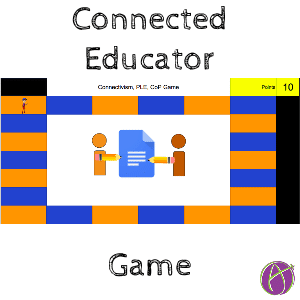For my class I am taking I was asked to visually represent Connectivism, Communities of Practice (CoP), and Personal Learning Environments (PLE). For this activity I created a board game prototype to allow you to move around the board as you engage with the images.
To play the game, make a copy of the game board. Use the Add-On menu to find the GameBoard Add-On. This will open a sidebar with two buttons on it. For each image that appears in the center of the board, determine if it represents Connectivism, a Community of Practice or a Personal Learning Environment. This game should be played with another player to allow for discussion over the images. If you agree click on the “Add Points” button. If you disagree, click on the “MINUS points” button in the sidebar.
To create this game I first designed the spreadsheet to allow the character image to move around the board as points increased. I created Google Drawings of different representations of Connectivism, Communities of Practice and Personal Learning Networks based on the resource materials from the class. Publishing the drawings to the web and inserting the links to the drawings in the spreadsheet allowed for the images from the Google Drawings to appear in the spreadsheet. Using a random number generator, a random image from the Google Drawings appears in the center of the game board. Using Google Apps Script, I created an Add-On menu with two buttons to add or subtract 10 points from the overall score.
This game represents a first prototype for using a spreadsheet game to display content. I will develop this into a template that will allow any teacher to use this as game with their students, specific to their content. Where I struggled was in the time limit of developing the spreadsheet, drawings and formulas. The design of the game needs improvement, suggestions for how game play might work better are greatly appreciated.
[expand title=”Click Here for additional information about Connectivism, Communities of Practice and Personal Learning Networks”]
Connectivism
Images that support the idea of Connectivism should show how learners connect their learning to things they already understand (Siemens, 2014). Learners are seeking to learn and this may be a messy process of discovery and will not look the same for all learners. Bell (2010) notes that knowledge can be viewed as a social activity, learners may connect their learning with other people to help construct their understanding of the information.
Communities of Practice
Images that support the idea of a Community of Practice should demonstrate where learners are interacting, intentionally, with others around a shared experience or interest (Chunk, 2015).
Personal Learning Networks
Images that support a Personal Learning Network will emphasize informal learning, probably through not structured interactions (Pataraia, 2015). Learners will learn on their own and pull from the experiences of others. This informal network of ways the learner accesses information and makes connections is defined by the learner, not assigned.
Resources
Bell, F. (2010). Connectivism: Its place in theory-informed research and innovation in technology-enabled learning. The International Review Of Research In Open And Distributed Learning, 12(3), 98-118.
Chung, K. S. K., & Paredes, W. C. (2015). Towards a Social Networks Model for Online Learning & Performance. Journal of Educational Technology & Society, 18(3), 240-253.
Pataraia, Nino (2015). “How and what do academics learn through their personal networks”. Journal of further and higher education (0309-877X), 39 (3), p. 336.
Siemens, G. (2014). Connectivism: A learning theory for the digital age. International Journal of Instructional Technology and Distance Learning, 2(1), 3-10.
[/expand]









